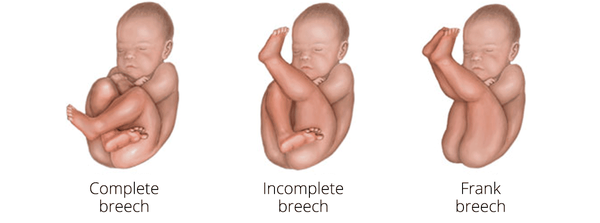Breech baby
Why is your baby breech?
Most of the time it is only a matter of chance that a baby does not turn and remains in the breech (bottom down) position. In few situations certain factors make it difficult for a baby to turn during pregnancy. These might include the amount of fluid in the womb (either too much or too little), the position of the placenta or the presence of more than one baby. The majority of breech babies are born healthy but, for a small minority of babies, breech may be a sign of a problem with the baby and therefore all breech babies will have a newborn examination.

What can be done?
If you are at 34 weeks and your baby is in breech position your midwife or obstetrician will refer you to the breech clinic at Chelsea and Westminster Hospital or the day assessment unit at West Middlesex University Hospital. At this clinic you will be seen by a specialist midwife who discuss with you your options of:
- Moxibustion
- External cephalic version (ECV)
- Choices for birth (vaginal breech delivery or Caesarean section), if your baby is still in a breech position after 39 weeks
What is moxibustion?
Moxibustion (a treatment method of traditional Chinese medicine) involves the burning of a herb (artemisia vulgaris) close to the skin to induce a warming sensation (Turner 1991). Moxibustion close to the acupuncture point Bladder 67 (BL67—Chinese name Zhiyin), located at the tip of your fifth toe, may correct breech presentation. Women with a breech presentation may seek treatment with moxibustion from 32–38 weeks. Published evidence suggests that moxibustion is effective in reducing the need for an external cephalic version (ECV).
This technique involves holding moxa sticks (1.5cm in diameter and 20cm in length) or burning moxa cones on or over BL67 on both toes. The heat felt should be warm but not uncomfortable. Treatment regimens vary and there is no consensus on the best regimen, but moxibustion may be administered for 15–20 minutes daily for up to 10 days. There have been no reported side-effects for mothers or babies.
After trying moxibustion for 10 days you will be reviewed again either in the breech clinic or the day assessment unit at 36 weeks and the midwife will check the position of your baby. If your baby is still breech and you opt for an ECV, you will be shown a short video and an ECV appointment will be arranged for you.
What is ECV?
ECV or external cephalic version is technique used to try to turn your baby to a head-first position. ECV increases the likelihood of having a vaginal delivery. It is usually tried after 36 weeks and can be attempted right up until you give birth.
Does ECV always work?
ECV is successful in about 50% of women. Relaxing the muscles of the womb with medication during an ECV is likely to improve your chance of success. This medication does not affect your baby. If your baby does not turn, it is possible to have a second attempt on another day. Your midwife or obstetrician will advise you further if they think a second attempt is reasonable.
Is ECV safe for me and my baby?
ECV is generally safe and does not cause the labour to begin. The baby’s heartbeat will be monitored before and after the ECV. Complications can sometimes occur but this is very rare. About one in 200 (0.5%) of babies need to be delivered by emergency Caesarean section immediately after an ECV. This may be due to bleeding from the placenta and or changes in the baby’s heartbeat. Your baby’s heart rate will be monitored before, during and after the procedure to ensure s/he is not in distress. Your ECV will also be attempted on the labour ward where there is immediate access to facilities should you need delivery by emergency Caesarean section.
The ECV should not be carried out if:
- you need a Caesarean section for other reasons
- you have had vaginal bleeding during the previous seven days
- the baby’s heart tracing (CTG) is abnormal
- your womb is not a normal pear shape (some women have a womb which resembles a heart shape, known as bicornuate uterus)
- your waters have broken before you go into labour
- you are expecting twins or more (except if after delivering the first baby, the second baby is breech)
How is ECV performed?
A specialist midwife will carry out the ECV and an obstetrician will scan. Gentle pressure is applied on your abdomen which helps the baby to turn in the womb to lie head first. It will take no more than three attempts over a ten-minute period followed by fetal monitoring for one hour. Afterwards you can go home with a follow-up plan.
Sources and acknowledgements
This information is based on the recommendation of the Royal College of Obstetricians and Gynaecologists (RCOG). Useful links:

